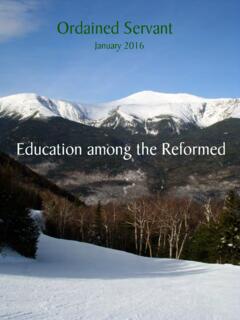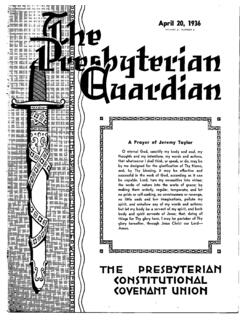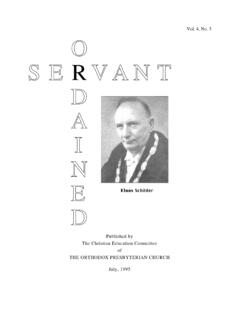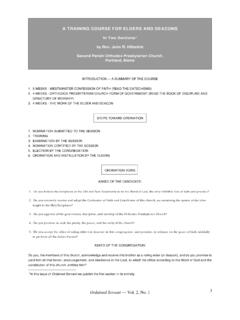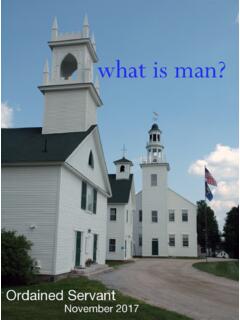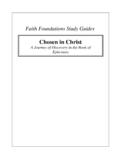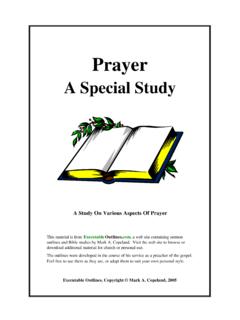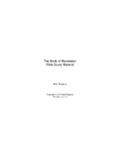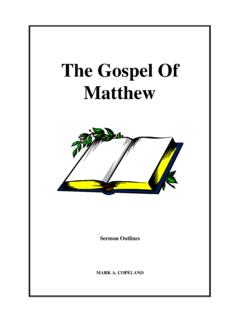Transcription of STUDY YOUR BIBLE - Orthodox Presbyterian Church
1 STUDY your BIBLE A Self STUDY Course for BIBLE BELIEVING CHRISTIANS BY EDWARD J. YOUNG WM. 6. EERDMANS PUBLISHING CO. Grand Rapids, Michigan r COPYRIQHT 1934. BY WM. B. EERDMANS PUBLISHINQ COMPANY ALL RIQHTS RESERVED. PRINTED IN THE UNITED STATES OF AMERIOA FOREWORD HERE is no need for me to say anything about the quahneations of Mr. Young. That the work is written 'in and able manner must be apparent to any one vho looks into it. Any individual or any group of individuals studying thc BIBLE the help of Mr. Young's work will naturally become convinced of the absolute truth of the Word of God. Und~rlying and permeating the book is the Re- formed conception of Apologeties, which holds that we can without fear even in our day hold to an absolute God, an absolute Christ, and an absolute BIBLE . There is no com- promise or crouching fear. With full acquaintance with the work of negative criticism and modurn philosophy, Mr.
2 Young holrls that unless we may take the BIBLE as truc, human lifc is meaningless. Surely young people of Christian homes need the help of such a STUDY . With a true conception of Apologetics goes a true con- ception of history, espeeially of sacred history. The truth of the creation story is maintained in opposition to the dogma of evolution. The fall of man not merely as "psy- chologically truc," but as an historical event, is shown to be at the root of all the sin in this world. The far-reach- ing significance of the doctrine of total depravity as well as its Scriptural foundation is made clear. I wish I could ~ve something like an adequate expres- to no other nation; the ;ev&tion to Israel is unique. The similarity of form of this revelation to other "reve- lations" does not detract from its uniqueness. Nowhere but in Scripture does an absolute God speak. Nowhere but in Scripture is redemption by pure grace alone.
3 No- where but in Scripture is there a program of the de- struction of all sin in evil. Nowhere but in Scripture is there the picture of absolute victory at last. Thus sacred history becomes terrible and beautiful. It grips one in the,inmost depths of his existence, There is no epic so sweeping, no drama so dramatic as the story of s;iered history when told after the Reformed conception of it as has been done by Mr. Young. Naturally RIr. Young does not tell the whole story. His hooks covers Gcncsis only. But the story of sacred history has its beginnings in Genesis. To tell the story of Genesis well is to help us on the right track. In Amcrican history the revolutionary period is uf basic importnncc. In sacred history the period of Genesis is of basic irnpurtance. The principle of God's sovereinn grace is the constitu- tional principle of the people of God. Mr. Young has brought this out in admirabls fashion.
4 He helps us to read our Bibles aright. We see one people uf Gud, with mc constitution, governed by one King, namely Jesus Christ. Thcrc is carcful attention to detail but never at thc crpense of insight into plan of the whole story. The divi- sion of the book into convenient lessons, with suggestions for further STUDY in the Biblc and the Catechism, with rcfercnces to the best literature on each topic under dis- cussion, makc thc hook eminently useful for cI~ss-worl~ as well as for private STUDY . If Sunday scI~ouI tcaehers and other teachers of the Biblc would master the method af Biblc STUDY and the prineiplc of sacred history as these appear in the short hook of hlr. Young, I am pcrsuaded that they would be bctter fitted to STUDY and tach the Biblc than they would be if they should read hundreds of pages of the ordinary material iiuw available to them. CORNELIUS VAN TIL, Professor of Apologetics.
5 Westminster Theological Seminary, Philadelphia, July, 1934. INTRODUCTION HOW TO USE THIS COURSE HIS COURSE is the result af a conviction that there T are many people who would STUDY their BIBLE , but who, from a lack of knowledge of how to do this, permit the BIBLE to remain a closed Book to them. There are BIBLE schools and theological seminaries and available commen- taries, but not all can attend school, nor do all have the time or ability to STUDY the commentaries. This work is designed for every-day people who are Will- ing to spend ten or fifteen minutes daily in BIBLE STUDY . But while this work is primarily intended for individual STUDY , it may also be used to good advantage by BIBLE classes, STUDY groups, and for prayer meetings. In this course WF cover only the book of Genesis, which serves as an introduction to the BIBLE , hut the student who works through these lessons faithfully will discover that he is in a position to carry on his BIBLE studies intelligently.
6 He will also have acquired a panoramic view of the BIBLE and its message, which Will greatly aid him in further STUDY . The student will note that there are thirty lessons. Each lesson consists of comments upon the BIBLE text, fol- lowed by exercises. If the student will spend from ten to fifteen minutes daily upon each lesson, he will complete one lesson in a week s time. At this rate, it will take thirty weeks, or a little over seven months to complete the whole course. In studying the lesson, the student should read the BIBLE text and compare it with the notes and com- ments given in each lesson. The heart of each lesson con- sists in the exercises, the answers to which are ALWAYS to be WRITTEN. In writing these exercises, the student may use both the BIBLE and the lesson notes freely, but he should be sure that he always writes the answers to the exercises. At the end of some lessons, OPTIONAL EXER- CISES are inserted, which consist, for the most part of selections for memory.
7 These optional exercises are in- tended only for those students who have extra time at their disposal; the average student may omit them. Fol- lowing the exercises of each lesson, hymns are inserted for STUDY with which the studcnt is earnestly advised to become acquainted. The point of view adopted in these lessons is that of the historic Reformed faith . Most of the material herein presented is from notcs taken in the classrooms of that groat school of theological learning, Westminster Theo- logical Seminary af Philadelphia. The author counts it me af the great hlcssings of his life to have hcen privi- leged to stndy in this stronghold of the Rcfvrmcd faith . Hc would extmd a general acknowledgement to Rev. Os- wald T. Allis, Professor of Old Testament in Westminster Seminary, from whose classroom lecturcs much of the material of this course was obtained. Yct, the author assumes the responsihility for each statement made in these pages.
8 He is also exceedingly gratcful to Rev. Cor- nelius Van Til, Professor of Apologetics, Rev. R. B. Kuiper, Professor of Practical Theology, Rev. Julm Murray, In- structor in Systematic Theology, all of Westminster Theo- logical Seminary, and Rev. James Moore, of Baltimorc, for their kindness in reading thc manuscript and in offering suggestions. If this little work will in any way aid in the spread of the Reformed faith . and's0 in the exaltation of our Lord ~ ~~~ ~ Jesus Christ, it wili then have accomplished the purpose for which it was written. IXSSON ONE S WE TURN to the first chapter of the BIBLE , let us A ask Gad to prepare our hearts and minds for receiv- ing the message which He has caused to bc written therein. We cannot stress too strongly the need of genuine prayer for understanding the BIBLE . The BIBLE is God s Word: He is its Author, and He is the final Interpreter.
9 Let the student, then, make it a habit to begin his STUDY of the BIBLE with prayer. **. Read the first chapter of Genesis. Our purpose in this first lesson is not to STUDY the chapter in detail, but rather, to obtain a panoramic view of its teachings. The great, primary emphasis here is upon the fact that God is the Creator of all things. How could Moses, who wrote these words,* know that God was the Creator of all? He could know it, only because God had revealed the fact to him. Have you ever stopped to think that Christianity is the only religion which consistently teaches that God is Al- mighty and that He is the Creator of all? Other religions sometimes call their god a creator, but they also say that their god was created or that he was dependent upon some other god or force. It is precisely at this first verse that Christianity parts company from all other religions and philosophies.
10 Note how Moses stresses the fact that God is the Creator! He uses the word God thirty-two times in this chapter, and there are only five verses in which the word does not ockur. Note, too, how the creative activity of God is stressed; it is said that God created, said, saw, divided, called, made, set, and blessed. Finally, we are told that God made every- thing good. The Divine approval rested upon the finished work of creation. As you read this chapter, you will discover that we are not told how God created. The stress, rather, lies upon 8 STUDY your BIBLE the fact that it is God Who created. There are, however, somc things which we shall do well to note. The creating activity of God is divided into six periods of time, called days. In each one of thesc days, God speaks or commands, and by rcnson of this command, somcthing is produced. Thus, in the first day, God gives the command, Let there be light, and cumm:md is fulfilled, And there was light.
